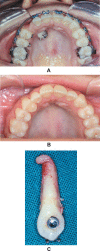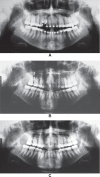Partial maxillary osteotomy following an unsuccessful forced eruption of an impacted maxillary canine: 10 year follow-up. Review and case report
- PMID: 23329250
- PMCID: PMC3881860
- DOI: 10.1590/s1678-77572012000600013
Partial maxillary osteotomy following an unsuccessful forced eruption of an impacted maxillary canine: 10 year follow-up. Review and case report
Abstract
The maxillary canines are amongst the most frequently impacted teeth, second only to the third molars. Several conservative orthodontic and surgical techniques are available to position the teeth properly in the dental arch, even in severe cases. However, when an extraction is necessary, it often leaves a critical alveolar defect of difficult management. The authors present the technique of partial maxillary osteotomy, in which a dento-alveolar segment is moved mesially, hence closing the remaining space, allowing for the formation of healthy periodontium and resulting in an adequate functional and aesthetic outcome. A case report is presented with a 10 year follow-up, proving the technique's stability in the long term.
Figures




Similar articles
-
Maxillary canine impactions related to impacted central incisors: two case reports.J Contemp Dent Pract. 2007 Sep 1;8(6):72-81. J Contemp Dent Pract. 2007. PMID: 17846674
-
Open surgical approach to a maxillary impacted canine: a case report.Int J Orthod Milwaukee. 2013 Fall;24(3):25-8. Int J Orthod Milwaukee. 2013. PMID: 24358653
-
Efficacy of the technique of piezoelectric corticotomy for orthodontic traction of impacted mandibular third molars.Br J Oral Maxillofac Surg. 2015 Apr;53(4):326-31. doi: 10.1016/j.bjoms.2015.01.002. Epub 2015 Jan 28. Br J Oral Maxillofac Surg. 2015. PMID: 25638568 Clinical Trial.
-
Forced eruption of a labially impacted maxillary canine with a transcoronal stainless wire: report of case.ASDC J Dent Child. 2000 Jul-Aug;67(4):288-92. ASDC J Dent Child. 2000. PMID: 10997247 Review.
-
Office-based procedures for unusual impactions.Atlas Oral Maxillofac Surg Clin North Am. 2013 Sep;21(2):211-20. doi: 10.1016/j.cxom.2013.06.001. Atlas Oral Maxillofac Surg Clin North Am. 2013. PMID: 23981496 Review. No abstract available.
References
-
- Alessandri Bonetti G, Incerti Parenti S, Daprile G, Montevecchi M. Failure after closed traction of an unerupted maxillary permanent canine: diagnosis and treatment planning. Am J Orthod Dentofacial Orthop. 2011;140:121–125. - PubMed
-
- Alqerban A, Jacobs R, Fieuws S, Nackaerts O, SEDENTEXCT Project Consortium, Willems G. Comparison of 6 cone-beam computed tomography systems for image quality and detection of simulated canine impaction-induced external root resorption in maxillary lateral incisors. Am J Orthod Dentofacial Orthop. 2011;140:129–139. - PubMed
-
- Bass TB. Observations on the misplaced upper canine tooth. Dental Pract Dent Rec. 1967;18:25–33. - PubMed
-
- Becker A, Chaushu G, Chaushu S. Analysis of failure in the treatment of impacted maxillary canines. Am J Orthod Dentofacial Orthop. 2010;137:743–754. - PubMed
-
- Bishara SE. Impacted maxillary canines: a review. Am J Orthod Dentofacial Orthop. 1992;101:159–171. - PubMed
Publication types
MeSH terms
LinkOut - more resources
Full Text Sources

